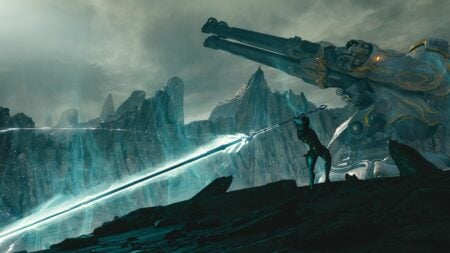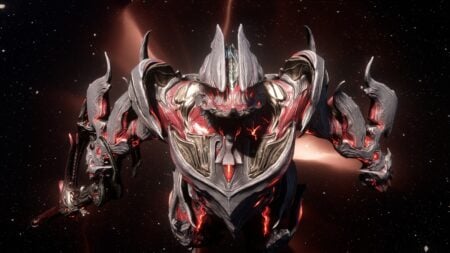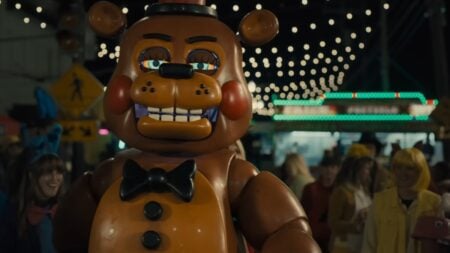Skip To...
Justice isn’t blind in RoboCop: Rogue City, and you can’t help but see the problems in Old Detroit. Teyon’s new action RPG combines the fast, gory shooting of Duke Nukem with the crime scene detective work of the Arkham series, splashing the whole thing with ’80s glam and a generous amount of social commentary. It’s an enticing premise, but the execution leaves much to be desired. If all you’re looking for is some mindless action and a jolt of nostalgia, Rogue City is a decent option. Unfortunately, numerous flaws hold the game back, making it a disappointing experience even for fans of this popular cybercop.
RoboCop: Rogue City Review

Rogue City takes place between RoboCop 2 and 3, so its world and cast will be instantly familiar to fans. Its gameplay alternates between law enforcement and investigating crimes. The former includes everything from parking tickets to explosive gunfights with dozens of criminals. Between core missions, you return to the precinct to chat with your fellow officers and take on side quests. An RPG-lite system allows you to level up your skills, creating a cybercop that’s better tuned to your particular playstyle. The main story’s trajectory is also in your hands, with dialogue choices allowing you to shape it for better or for worse, though you soon realize how little freedom you actually have.
Story: New Man in Town

Old Detroit’s police department is struggling to keep up with the crime plaguing the city. A megacorp known as Omni Consumer Products has bought and privatized the police force in an attempt to restructure things and bring crime back under control. Around the same time, Officer Alex Murphy suffered near-fatal injuries on the job, and the department used cybernetics to save his life. Murphy, reborn as the cyborg RoboCop, becomes the spear-point for OCP’s renewed efforts to eradicate crime in Old Detroit. Despite OCP, the city is only getting worse.
Something is stirring the Torch Heads and other gangs into a frenzy of violence. It’s the arrival of a mysterious new man in town. Little is known except that he’s wealthy and determined to transform the city one crime at a time. OCP and RoboCop launch into action to unravel the mystery of this stranger. Someone needs to put a stop to him and his allies, and no one else is stepping up to do the job. It’s a two-dimensional plot and a harsh corporate future befitting Cyberpunk, but at least that’s in keeping with the original film.
In fact, many elements of Rogue City are ripped directly from the original RoboCop. The developer knows its source material well, and fans of the original will find numerous characters, locations, and other elements that were present in the movies. The police station is a lovingly modeled recreation of the film’s set, and the game’s other levels match its aesthetic perfectly. Key characters like Officer Anne Lewis and Sergeant Warren Reed play crucial roles in the plot, and it feels nice to actually interact with the characters that made the movie so good.

There’s a massive disconnect between the serious central plot and the silliness of side missions. As the Yakuza series proves, that’s not necessarily a problem as long as you do it well. RoboCop simply doesn’t. Side missions are occasionally good, but most of them are tedious fetch quests or lifeless investigations. Main story missions are typically fun, but its side quests are the worst kind of thoughtless busywork. Compared to a game that values story as much as fun, it’s a painful contrast. Running around the station gathering signatures for a card just isn’t engaging.
The game’s biggest problem is the rift between its themes and story. The original RoboCop film is an inherently political one, using its cheesy robot action to ask pointed questions about society and policing. Though often problematic, it’s genuine in its desire to grapple with these themes. To put it bluntly, Rogue City feels insincere. RoboCop isn’t the blind hand of justice: he’s a fickle, fallible, murderous cyborg who pays lip service to warrants and the law only to violate citizens’ rights or just shoot them in the face without warning. The original RoboCop was released in 1987. Since then, society’s relationship with policing has evolved in complicated ways that Rogue City outright fails to address.
People with substance abuse issues, unhoused people, and sex workers all receive unflattering treatment here. When asked to intervene in an altercation between a store owner and two young people playing music outside, every dialog option forces you to side with the shopkeeper. Options range from telling the youths off to threatening them with electrocution. There’s no nuance, no attempt to investigate further, and no way to de-escalate. You are pitted against the youths, making the entire scenario feel badly written and morally gross.
Gameplay: Shiny Scrap Metal

Gameplay in RoboCop: Rogue City consists of investigations, law enforcement, and shootouts. Investigations play out like a watered-down, less satisfying version of Batman’s forensic scenes in the Arkham games. You search for clues, scan them to gain further insight, and then repeat. After enough clues, your investigation can proceed. It’s not a bad system, it’s simply been done better elsewhere. Clues sit in plain sight, and interrogations have no depth. It makes you feel like you’re just going through the motions on your way to an inevitable conclusion.
The gunfights, thankfully, are great. They feel a bit limited at first, but once you upgrade your Auto 9 and put some points into your various skills, shootouts become extremely satisfying. You can dash, ricochet bullets off of walls, deploy a temporary shield, and slow down time like Max Payne. There are almost two dozen guns in the game, which makes for decent variety. Aside from a couple with clunky ADS and one underpowered pistol, everything feels fantastic. You breach a door, then slow time to line up headshots, exploding criminals like gory fireworks.
RoboCop is the definition of OP. He’s a walking tank capable of single-handedly killing a small army, perfectly fitting the power fantasy of the series. Enemy bullets are a mere inconvenience unless you get swarmed or expose yourself to sniper fire. Most of your own guns, meanwhile, are hilariously strong. You can also customize RoboCop’s signature Auto 9 pistol as you progress through the campaign. Doing so grants it perks such as armor-piercing capability or unlimited ammo. Other than one or two spongy bosses, nothing stands in the way of the Auto 9.

There’s no real reason to use other weapons most of the time, but the assortment of automatics, shotguns, snipers, and explosives feels good and is useful for certain scenarios. The most fun, however, comes with using your own hands. RoboCop’s punch will one-shot most enemies and fling them back like they were hit by a truck. What’s even better? Grabbing an enemy and throwing them into their friends, off a ledge, or straight up into the air before unloading on them with your gun. Treating criminals like clay pigeons has never been more satisfying.
Though combat is the game’s highlight, it has its faults. Being a walking tank means RoboCop barely flinches when struck by bullets. It’s true to the character, but it makes playing as him feel less tangible and gritty than this kind of shooter should. His run speed is too slow, which doesn’t matter most of the time, but it becomes irritating when backtracking through large levels. His dash is floaty in Rogue City, making it feel like someone shoved RoboCop across an ice rink. Ability cooldowns are also questionable. You can’t use the dash until its long cooldown finishes, but you can spam time dilation after just a second or two of recovery.
Excellent ragdolling and enough blood for a Mortal Kombat fatality don’t do much to distract from other irritating issues. There are a handful of genuinely clever and engaging levels, but thoughtless level design lets down much of the game. You can pick your path through most areas, deciding which crimes to investigate and in what order. Most urban areas, however, feel boxy and barren, with just a handful of points of interest scattered throughout them. These spaces are reminiscent of player-made FPS maps from any number of popular ’90s shooters, and not in a flattering way.
Graphics & Sound: Grime and Nostalgia

RoboCop approaches a crumbling brick wall, pausing to listen as men argue on the other side. Raising a metallic fist, he smashes through. Time slows, giving him time to level his Auto 9 at the kidnappers. The hostages are kneeling, handcuffed, in front of their captors. Hesitation would spell death for them. Each squeeze of the Auto 9 sends a burst of bullets into the stunned kidnappers. Their heads pop like balloons of blood. At its best, RoboCop: Rogue City is every bit the gory action spectacular that the film was.
When it comes to graphics, the game gets an A for blood, gore, and nostalgia but a B for everything else. The developer’s art team did a fantastic job of recreating characters and sets from the original. Longtime fans of the series will delight at the opportunity to explore the police station, from intake and the jail to the locker room and shooting range. If you’re mostly interested in feeling like you’ve stepped into the movie, you won’t be disappointed. Sound design in the game’s urban areas feels hollow, however, due to a lack of layered ambient noises. Combined with the overall lack of points of interest, Old Detroit feels empty.

Peter Weller, the original RoboCop actor, returns to voice the cybercop in Rogue City. He performs admirably, and it’s a genuine treat to hear him in the role again. As for the other voice actors, the results are mixed. The characters’ stiff facial animations don’t do justice to the voices behind them. It’s a problem that mediocre dialog only makes worse. Award-winning performances aren’t what attracted most fans to the franchise in the first place, but compared to the stellar voice work in other recent games, it’s a downgrade.
Rogue City feels stuck mid-transformation. Visually and conceptually, it owes more to Duke Nukem than it does most modern FPS. As a fan of boxy, old-school shooters like Quake and Turok, I can’t help but be disappointed. The bones are solid, but there’s little meat on them. It leaves you waiting for a main course that never arrives. The developer nails small details, such as the scan lines that appear in RoboCop’s vision. Unfortunately, it fumbles with set design, atmosphere, and even particle effects. Though it runs smoothly and is mostly bug-free, there are jarring visual glitches when transitioning between animations with certain guns.
Conclusion: Unprotected and Underserved

RoboCop: Rogue City pays lip service to freedom of choice while railroading you toward a pre-conceived destination. Yes, your choices can change which characters like you and who takes power in Old Detroit. You still have no power over anything of substance. It’s hard to see RoboCop as a beacon of justice when he and everyone he works with are essentially amoral killers who value property more than human rights. When a game insists upon drawing attention to its themes, it would be irresponsible to ignore them, especially when they’re so problematic.
RoboCop is far from heroic in Rogue City, despite the occasional act of genuine virtue. For some, a game’s message doesn’t matter as long as it’s fun. The problem is Rogue City often isn’t. Flaws in level design, facial rendering, audio, combat balance, and mission construction all hold back what could otherwise be a delightful and nostalgic FPS. If you’re a diehard fan of the franchise, want to chuck some bad guys off of buildings, and can ignore the game’s glaring issues, RoboCop: Rogue City may be a fun way to kill a weekend or two. For everyone else, there are better shooters that feature this cybercop.
Robocop: Rogue City is available for PC, PlayStation 5, and
RoboCop: Rogue City (PC Reviewed)
An explosive FPS hampered by superficial choices and poor understanding of the source material.
Pros
- Excellent combat
- Faithful recreation of the original setting
- Tons of nostalgic references
Cons
- Disappointing story and theme
- Empty choices
- Mediocre level design







